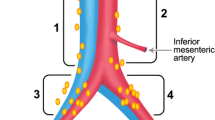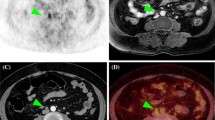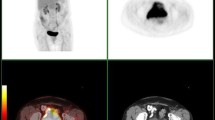Abstract
The purpose is to evaluate the accuracy of integrated 18F-fluorodeoxyglucose (FDG)-positron emission tomography (PET)/computed tomography ((CT) with intravenous contrast medium in detecting pelvic and paraaortic lymph node metastasis in patients with uterine cancer, with surgical and histopathological findings used as the reference standard. Forty-five patients with endometrial or uterine cervical cancer underwent radical hysterectomy, including pelvic lymphadenectomy with or without paraaortic lymphadenectomy, after PET/CT. PET/CT findings were interpreted by two experienced radiologists in consensus. The criterion for malignancy on PET/CT images was increased tracer uptake by the lymph node, independent of node size. The overall node-based sensitivity, specificity, PPV, NPV and accuracy of PET/CT for detecting nodal metastases were 51.1% (23/45), 99.8% (1,927/1,931), 85.2% (23/27), 98.9% (1,927/1,949) and 98.7% (1,950/1,976), respectively. The sensitivity for detecting metastatic lesions 4 mm or less in short-axis diameter was 12.5% (2/16), that for between 5 and 9 mm was 66.7% (16/24), and that for 10 mm or larger was 100.0% (5/5). The overall patient-based sensitivity, specificity, positive predictive value ((PPV), negative predictive value (NPV), and accuracy were 50% (6/12), 90.9% (30/33), 66.7% (6/9), 83.3% (30/36) and 80.0% (36/45), respectively. Integrated FDG-PET/contrast-enhanced CT is superior to conventional imaging, but only moderately sensitive in predicting lymph node metastasis preoperatively in patients with uterine cancer.


Similar content being viewed by others
References
International Federation of Gynecology and Obstetrics (1995) FIGO staging of gynecologic cancers. Int J Gynecol Cancer 5:319–324
Manetta A, Delgado G, Petrilli E, Hummel S, Barnes W (1986) The significance of paraaortic node status in carcinoma of the cervix and endometrium. Gynecol Oncol 23:284–290
Creasman WT, Morrow CP, Bundy BN, Homesley HD, Graham JE, Heller PB (1987) Surgical pathologic spread patterns of endometrial cancer. Cancer 60:2035–2041
Inoue T, Morita K (1990) The prognostic significance of number of positive nodes in cervical carcinoma stageIB, IIA, and IIB. Cancer 65:1923–1927
Gal D, Recio FO, Zamurivic D, Tancer ML (1991) Lymphovascular space involvement. A prognostic indicator in endometrial adenocarcinoma. Gynecol Oncol 42:142–145
Stehman FB, Bundy BN, DiSaia PJ, Keys HM, Larson JE, Fowler WC (1991) Carcinoma of the cervix treated with radiation therapy: a multi-variate analysis of prognostic variables in the Gynecologic Oncology Group. Cancer 67:2776–2785
Lai CH, Hong JH, Hsueh S et al (1999) Preoperative prognostic variables and the impact of postoperative adjuvant therapy on the outcome of stageIB and II cervical carcinoma patients with or without pelvic lymph-node metastases: an analysis of 891 cases. Cancer 85:1537–1546
Chan JK, Cheung MK, Huh WK et al (2006) Therapeutic role of lymph node resection in endometrioid corpus cancer: a study of 12,333 patients. Cancer 107:1823–1830
Hricak H, Rubinstein LV, Gherman GM, Karstaedt N (1991) MR imaging evaluation of endometrial cancer: results of an NCI cooperative study. Radiology 179:829–832
Sugiyama T, Nishida T, Ushijima K et al (1995) Detection of lymph node metastasis in ovarian carcinoma and uterine corpus carcinoma by preoperative computerized tomography or magnetic resonance imaging. J Obstet Gynaecol 21:551–556
Connor JP, Andrews JI, Anderson B, Buller RE (2000) Computed tomography in endometrial cancer. Obstet Gynecol 95:692–696
Manfredi R, Mirk P, Maresca G et al (2004) Local-regional staging of endometrial carcinoma: role of MR imaging in surgical planning. Radiology 231:372–378
Rockall AG, Sohaib SA, Harisinghani MG et al (2005) Diagnostic performance of nanoparticle-enhanced magnetic resonance imaging in the diagnosis of lymph node metastases in patients with endometrial and cervical cancer. J Clin Oncol 23:2813–2821
Rockall AG, Meroni R, Sohaib SA et al (2007) Evaluation of endometrial carcinoma on magnetic resonance imaging. Int J Gynecol Cancer 17:188–196
Kim SH, Kim SC, Choi BI, Han MC (1994) Uterine cervical carcinoma: evaluation of pelvic lymph node metastases with MR imaging. Radiology 190:807–811
Scheidler J, Hricak H, Yu KK, Subak L, Segal MR (1997) Radiological evaluation of lymph node metastases in patients with cervical cancer: a meta-analysis. JAMA 278:1096–1101
Hawighorst H, Schoenberg SO, Knapstein PG et al (1998) Staging of invasive cervical carcinoma and of pelvic lymph nodes by high resolution MR imaging with a phased-array coil in comparison with pathological findings. J Comput Assist Tomogr 22:75–81
Yang WT, Lam WH, Yu MY, Cheung TH, Metreweli C (2000) Comparison of dynamic helical CT and dynamic MR imaging in the evaluation of pelvic lymph nodes in cervical carcinoma. AJR Am J Roentgenol 175:759–766
Reinhardt MJ, Ehritt-Braun CD, Vogelgesang D et al (2001) Metastatic lymph nodes in patients with cervical cancer: detection with MR imaging and FDG PET. Radiology 218:776–782
Choi HJ, Roh JW, Seo SS et al (2006) Comparison of the accuracy of magnetic resonance imaging and positron emission tomography/computed tomography in the presurgical detection of lymph node metastases in patients with uterine cervical carcinoma. Cancer 106:914–922
Cook GJ, Maisey MN, Fogelman I (1999) Normal variants, artifacts and interpretative pitfalls in PET imaging with 18-fluoro-2-deoxyglucose and carbon-11 methionine. Eur J Nucl Med 26:1363–1379
Kostakoglu L, Agress Jr H, Goldsmith SJ (2003) Clinical role of FDG PET in evaluation of cancer patients. Radiographics 23:315–340
Beyer T, Townsend DW, Brun T et al (2000) A combined PET/CT scanner for clinical oncology. J Nucl Med 41:1369–1379
Bar-Shalom R, Yefremov N, Guralnik L et al (2003) Clinical performance of PET/CT in evaluation of cancer: additional value for diagnostic imaging and patient management. J Nucl Med 44:1200–1209
Sironi S, Buda A, Picchio M et al (2006) Lymph node metastasis in patients with clinically early stage cervical cancer: Detection with integrated FDG PET/CT. Radiology 238:272–279
Loft A, Berthelsen AK, Roed H et al (2007) The diagnostic value of PET/CT scanning in patients with cervical cancer: a prospective study. Gynecol Oncol 106:29–34
Park JY, Kim EN, Kim DY et al (2008) Comparison of the validity of magnetic resonance imaging and positron emission tomography/computed tomography in the preoperative evaluation of patients with uterine corpus cancer. Gynecol Oncol 108:486–492
Kitajima K, Murakami K, Yamasaki E et al (2008) Accuracy of FDG PET/CT in detecting pelvic and paraortic lymph node metastasis in patients with endometrial cancer. AJR Am J Roentgenol 190:1652–1658
Sugawara Y, Eisbruch A, Kosuda S, Recker BE, Kison PV, Wahl RL (1999) Evaluation of FDG PET in patients with cervical cancer. J Nucl Med 40:1125–1131
Suzuki R, Miyagi E, Takahashi N et al (2007) Validity of positron emission tomography using fluoro-2-deoxyglucose for the preoperative evaluation of endometrial cancer. Int J Gynecol Cancer 17:890–896
Sachs S, Bilfinger TV, Komaroff E, Franceschi D (2005) Increased standardized uptake value in the primary lesion predicts nodal or distant metastases at presentation in lung cancer. Cancer 6:310–313
Kidd EA, Siegel BA, Dehdashti F, Grigsby PW (2007) The standardized uptake value for F-18 fluorodeoxyglucose is a sensitive predictive biomarker for cervical cancer treatment response and survival. Cancer 110:1738–1744
Shimoda W, Hayashi M, Murakami K, Oyama T, Sunagawa M (2007) The relationship between FDG uptake in PET scans and biological behavior in breast cancer. Breast Cancer 14:260–268
Harisinghani MG, Barentsz J, Hahn PF et al (2003) Noninvasive detection of clinically occult lymph-node metastases in prostate cancer. N Engl J Med 348:2491–2499
Harada T, Tanigawa N, Matsuki M, Nohara T, Narabayashi I (2007) Evaluation of lymph node metastases of breast cancer using ultrasmall superparamagnetic iron oxide-enhanced magnetic resonance imaging. Eur J Radiol 63:401–407
Acknowledgments
We thank the gynecologists, especially Ichio Fukasawa and Noriyuki Inaba, for recruiting patients to undergo PET/CT. We also thank Kennichi Kobayashi, Kouichi Asano, Kazufumi Suzuki, and Kaoru Ishida for their excellent technical assistance and generous support.
Author information
Authors and Affiliations
Corresponding author
Rights and permissions
About this article
Cite this article
Kitajima, K., Murakami, K., Yamasaki, E. et al. Accuracy of integrated FDG-PET/contrast-enhanced CT in detecting pelvic and paraaortic lymph node metastasis in patients with uterine cancer. Eur Radiol 19, 1529–1536 (2009). https://doi.org/10.1007/s00330-008-1271-8
Received:
Revised:
Accepted:
Published:
Issue Date:
DOI: https://doi.org/10.1007/s00330-008-1271-8




